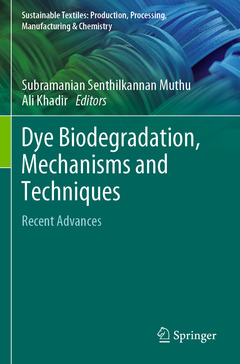Dye Biodegradation, Mechanisms and Techniques, 1st ed. 2022 Recent Advances Sustainable Textiles: Production, Processing, Manufacturing & Chemistry Series
Coordonnateurs : Muthu Subramanian Senthilkannan, Khadir Ali

An enormous amount of synthetic dyes is used annually in the textile, leather, plastics, paper, and dye industries due to their coloring properties. Although dyes give color to materials, they are prone to increase the level of pollution in the environment. The colored wastewater produced in industrial sectors is released into water bodies, posing threats to the ecosystem. To reduce the adverse effects of dyes in the environment, it is necessary to implement feasible and cost-effective strategies. '"Dye Biodegradation Mechanisms and Techniques - Recent Advances'' provides fundamental principles and pathways of bio-based mechanisms in dye removal. This edition firstly discusses dye classification and pollution, then concentrates on the application of fungi, mesophilic bacteria, microflora, and enzymes in dye degradation. This book also highlights the performance of sequential batch reactor systems, moving bed biofilm reactors, and hybrid bioreactors for dye biodegradation?
Dyes: Classification, Pollution, and Environmental Effects
Degradation of dyes using filamentous fungi
Bioremediation of dye using mesophilic bacteria: mechanism and parametric influence
Mechanism and Techniques of dye removal by microflora
Dye degradation by fungi
Enzyme action for dye degradation
Interaction of dye molecules with Fungi: Operational parameters and mechanisms
Effect of environmental and operational parameters on sequential batch reactor systems in dye degradation
Removal of dyes from wastewaters in moving bed biofilm reactors: a review of biodegradation pathways and treatment performance
Hybrid bioreactors for dye biodegradation
Dr. Subramanian Senthilkannan Muthu currently works for SgT Group as Head of Sustainability, and is based out of Hong Kong. He earned his PhD from The Hong Kong Polytechnic University, and is a renowned expert in the areas of Environmental Sustainability in Textiles & Clothing Supply Chain, Product Life Cycle Assessment (LCA) and Product Carbon Footprint Assessment (PCF) in various industrial sectors. He has five years of industrial experience in textile manufacturing, research and development and textile testing and over a decade's of experience in life cycle assessment (LCA), carbon and ecological footprints assessment of various consumer products. He has published more than 100 research publications, written numerous book chapters and authored/edited over 100 books in the areas of Carbon Footprint, Recycling, Environmental Assessment and Environmental Sustainability.
Ali Khadir is an environmental engineer and a member of the Young Researcher and Elite Club, Islamic Azad University of Shahre Rey Branch, Tehran, Iran. He has published/prepared several articles and book chapters in reputed international publishers, including Elsevier, Springer, Taylor & Francis, and Wiley. His articles have been published in journals with IF of greater than 4, including Journal of Environmental Chemical Engineering and International Journal of Biological Macromolecules. He also has been the reviewer of journals and international conferences. His research interests center on emerging pollutants, dyes, and pharmaceuticals in aquatic media, advanced water and wastewater remediation techniques and technology. At present, he is editing other books in the field of nanocomposites, advanced materials, and the remediation of dye-containing wastewaters.
Highlights recent advances and findings in dye bioremediation by means of fungi, mesophilic bacteria, and enzymes
Describes the underlying mechanisms and pathways of colored wastewater degradation
Discusses various bioreactors effective in dye removal, including their performance and operational parameters
Date de parution : 10-2022
Ouvrage de 285 p.
15.5x23.5 cm
Disponible chez l'éditeur (délai d'approvisionnement : 15 jours).
Prix indicatif 89,66 €
Ajouter au panierDate de parution : 10-2021
Ouvrage de 285 p.
15.5x23.5 cm
Disponible chez l'éditeur (délai d'approvisionnement : 15 jours).
Prix indicatif 126,59 €
Ajouter au panier


